At the most luxurious level of dressmaking - the “Haute Couture” YSL created clothes that were pure perfection in their construction, perfectly sublime in their proportion, ravishingly dazzling in their pure color and imaginative in the mix of color and texture. But, beyond all of that, his clothes had another dimension altogether, a cause célèbre for such a tribute. Each season he broke down stereotypes and barriers, setting women more free, empowering them with the clothes and style to boldly express their new freedom. YSL was a visionary artist who recognized the changing of the guard and had an active hand in ushering in a new freedom that helped shape women’s history. When YSL opened a new collection, women and journalists lined up to devour and embrace what he sent down the runway. He was king – he was an initiator, he was a visionary artist – he was the leader of the pack.
Today much of what he achieved is taken for granted, but forty-fifty years ago, when he had his first collections, it shocked and rocked the establishment. He understood the path to the future even though the general public was not always receptive, and reassured with interviews, magazine and television ads to explain his collections.
His followers, many legendary leaders in their respective fields, from actresses, to writers, artists, models, socialites or politicians, were like a devoted cult. This group of women, gathered from all avenues, lived colorful and exciting lives, celebrated for their thoughts, travels and actions. YSL understood their wishes and dreams and created clothes that naturally wove together their new lifestyles. His runways were for real people, his clients, they were not theatrical creations for media. Customarily YSL showed last in Paris, and his was the final word. No one touched him.
As much as we crave today’s fashion and adore the leading designers, it is fundamentally different from YSL’s collections. Today, each season is filled with more spectacular handbags, shoes, jeans, jewelry than the season before – it’s focused on the pièce de résistance. And though it is providing a wonderful thrill in our lives, the designers are not influencing history, not providing a new concept of clothing that influences history. To feel fashion’s footprint on society in the 21st century, one would need to look to the influence from ecological priorities, practical needs or the streets as opposed to fashion shows.
With my head full of all these thoughts I entered the Petit Palais. My expectations were high. Yet, as anxious as I was to see the exhibition, the grand entrance of the Palais is breathtaking, and I, like everyone else, stopped in my tracks, lingered, wandered around, and enjoyed the marvels of the entrance and its spacious proportions prior to entering the exhibition.
The exhibition, divided into 15 rooms, begins with the Dior years “Les Années Dior”. As one of Christian Dior’s assistants in 1958, YSL, at 21 years old, unexpected became his successor achieving immediate, critical success. Seven outfits are included in the exhibition from this period and they took me by surprise because they so encapsulate the dreams for 2010 and beyond. What I thought would have been old lady and boring was instead exquisite and pure. The dresses, suits, colors, textures, are soft, luminous, chic and classy. The first outfit is a silk faille crème tunic adorned with an oversized, navy, organza rose at the neck. It is layered over a slim navy skirt. Next to it is a grey flannel “Trapeze” day dress with a large pirouette collar and three quarter sleeves. The trapeze was one of the remarkable shapes that he invented. Even on the mannequin you feel the soft movement. Two evening dresses with fitted bodices opening into full skirted dirndls are again, light, soft and breezy, with the fullness achieved by delicate bias tape sewn around the underskirt hem. Couturier details such as scattered handmade flowers and tucks add romantic gracefulness. A day outfit was topped with a gently sculptured jacket, above wrist length sleeves, a Parda-ish curved shape in black crocodile verni, bordered in black mink and layered over a boucle brown slim skirt. It looked as modern and coveted today as it must have 50 years ago. This room summarized the key YSL artistry - taste, style, timelessness, flowers, pure, inventive, fresh, breezy, modern proportions. Can I say more, I loved the simplicity and perfection.
Next I wondered into “Studio Réel/Studio Mental” where his studio had been re-created. This was the “control center”, his world, where he sketched, fit and worked out his creations. On his actual desk, a simple table top on a pair of harnesses, were the often photographed, very personal collection of objects – a red glass heart, silver and bronze objects, a thick pad of note paper stamped YSL, his drawing pencils, colored pencils and drawing papers. A stack of books – Hollywood, Mondrian, Tunisia … lay on the left of his desk. Behind him more books lined shelves and fabric swatches, sketches, mementos and art were tacked on the wall. He didn’t travel, his ideas were imaginary, inspired by books, on artists, history and places. He derived inspiration from all these objects on hand, in his studio, as well as his extensive art collection.
Off the “studio” with music by Franck playing in the background, a small, dark room is filled with dresses from the “Bal de Proust.” Orchestrated by the dramatic hostess Marie Helene de Rothschild in 1971, it was a legendary party of fantasy and glamour. I gasped when I realized that the clothes displayed were the one’s YSL had specially created for Jane Birkin, Hélène Rochas, Nan Kempner and of course Rothschild …. to think, YSL, carte blanche, the imagination. Overdose.
The next room, “YSL et Les Femmes” has about a dozen outfits, each for one of his legendary patrons, from Paloma Picasso to the resistance fighter, Francoise Giroud, from his colleague, Elsa Schiaparelli to Diana Vreeland and Lauren Bacall. The clothes draw a circle around his devoted patronage, their varied lifestyles and how he understood and embraced them.
Then, in Room 6, “Catherine Deneuve, Une Rencontre” she opens her closet. This legendary French actress, whom he dressed in film, and beyond, reveals the contents of her closet, the reds, blacks, jewelry, shoes, all of it - the centerpiece, the little black robe with white satin color and cuffs from the film “Belle de jour.” Her intrinsically French style is ravishing and conceived by YSL.
YSL was the first designer to launch perfume with a provocative advertising campaign, photos, videos of songs, and gigantic blow-ups of his sketches are found in rooms 7 and the rotunda.
Room 9, is one of my personal favorites, “Eté 1971, Le Scandale de la Collection 40.” Inspired by fashion from the 40s, the reviews, pasted on the walls were devastating, condemning the collection as scandalously trying to glamorize the clothing from WWII. The collection did not sell, but it clearly defines how we dress today. The soft crepe-de-chine printed dresses mixed with novelty, oversized shoes and tailored jackets, the mix of pretty, colorful, retro, shaped, feminine or masculine – expresses a charming individuality.
Everywhere were his expressions and ideas (above) his New Year's posters, film, photos and information surrounding the various eras.
“Les Voyages Imaginaires” takes you to Spain, Russia, China, Japan and beyond. I’ve rambled on and on, and could write pages about these clothes, but one must see them. They are his imaginary conceptions of the romantic folkloric influences of these cultures. Rich, fantasy worlds that capture the magic through the colors, textures, silhouettes, embellishments and accessories associated with the country. All of it has been created by fine craftsmen and women. One wants all those different pants, the ethnic shapes, the luxurious breath of fabric. YSL was known to say that the Russian collection was his best ever. (I happen to have Vogue patterns from this collection. They require yards of material and I have never made anything. Vogue patterns used to be such a fashion resource.)
This is followed by “Dialogue avec L’Art.” Art by Vincent Van Gogh is breathtaking, intricately beaded on a jacket, Piet Mondrian (above) where block shapes are cut into wool jersey sheaths, and bronze metalized leather breast plates by Claude Lalanne are worn with floaty navy mousseline dresses and capes. It simply goes on and on and would take pages to describe. African crafts are re-created into evening mini dresses, and a knitted wool white dress, with white silk ribbons from 1965 is another enchanting idea of feminity.
Before Madonna or Lady Gaga he was wrapping women in bondage in bold, intricate, artistic ways that was thrilling. He was giving them dramatic ways to surprise and delight and feel beautiful.
The final room, which could have been an exhibition on its own, is “Le Dernier Bal.” One sees hundreds of ways to dress for the evening. From pure simplicity to outrageous pattern and color - every piece- becomes a jewel on its own. Then, lined floor to ceiling, 3 or 4 rows high, along the back wall, are “Le Smoking” his black pantsuit for a woman, for evening, immaculately tailored, so it falls on the body impeccably. Sometimes it is shaped as a jumpsuit, other times with shorts. It is shown with a black lace bra or a white blouse, each unique and stylish.
Finally the “Le Choc des Couleurs” where the walls are lined with his carefully clipped pages upon pages of fabrics swatches, arranged in vibrant colors and textures, unique shades of blue, green, red, yellow, bringing all the senses to feelings of nature, birds of paradise, somewhere between life and dreams. In between the panels of fabrics the floating, mousseline draped evening dresses from his final collection of 2002. They are pure, exceptional for their simplicity.
The exhibition ends with a film from this farewell show. You glimpse the models wearing many of the clothes one has just seen in the exhibition. They all come to life, taking on another character, with soft fluid movements, and one realizes that actually, in the end, the point was how they move, sweep, prance and come to life. The models communicate the pleasure of wearing the clothes and it’s very personal.
Like how Andy Warhol (above) used the medium of screen printing to express his statements about society, YSL used women’s clothing as his means to express and reflect on society.
Above - my ticket stub. Below - a sculpture off the main corridor.
And finally, the Eiffel Tower at night as one bids farewell to Paris.
I have certainly rambled on and on, and I only hope it sparks your interest, as it certainly did mine. À bientôt.

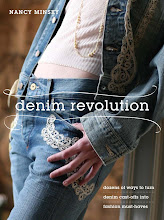




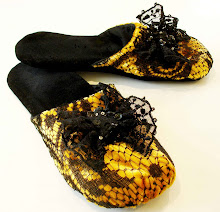
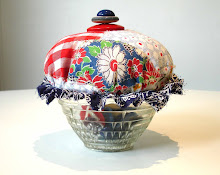




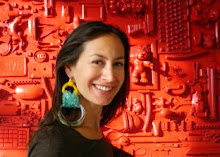




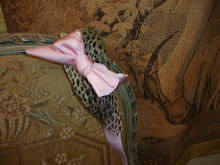
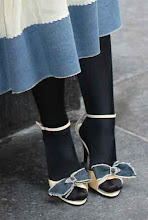







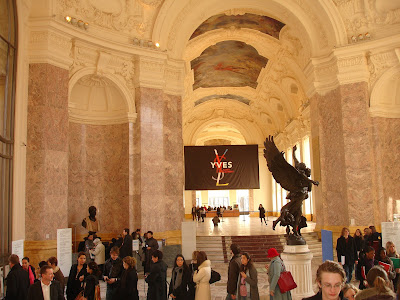










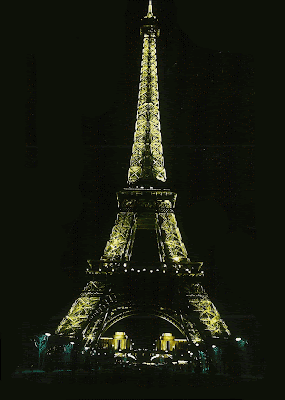

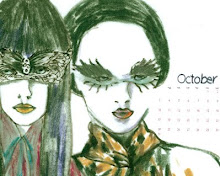





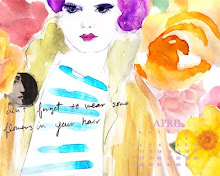
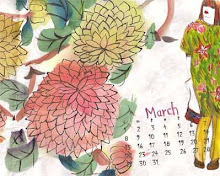
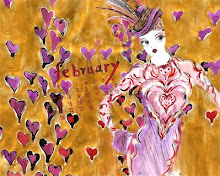

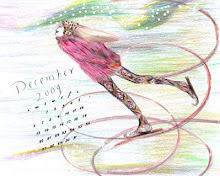
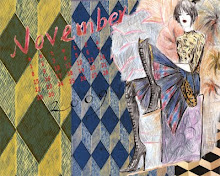



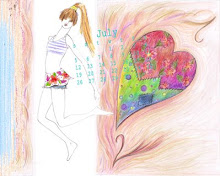
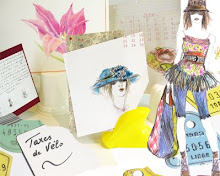
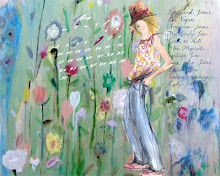
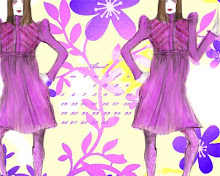
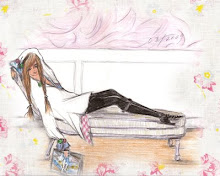
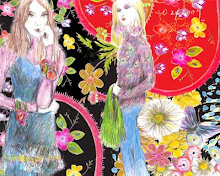
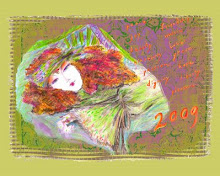



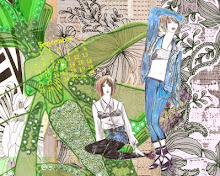








2 comments:
What a wonderful post!
I wish you would have been there with me - you would love the exhibition!
Post a Comment